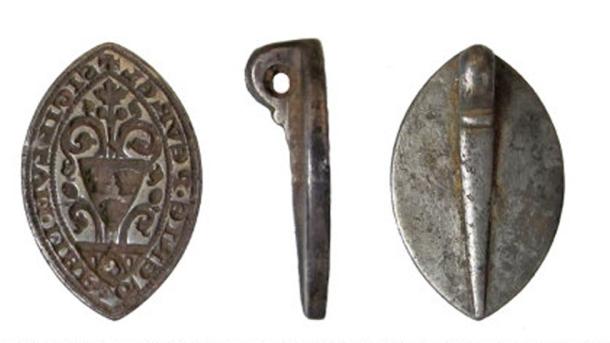Silver Signature: Medieval Seal Brings a Woman’s Life to Light
Sometimes a small archaeological find can provide really important insights into our past. A metal detectorist found a tiny artifact that belonged to women who lived in the 14th century in Britain. A medieval seal matrix was found and it is helping researchers to understand the life of a woman from a noble family who lived 700 years ago.
The medieval silver seal matrix was found by a metal detectorist in Hambleden, Buckinghamshire, in the south of England in April 2019. Detectorists have uncovered many artifacts in Britain in recent years. The finder brought the discovery to the attention of the local coroner’s office, which is required by law. ‘Buckinghamshire assistant coroner Alison McCormick declared it treasure,’ according to the BBC.

The medieval seal matrix has been declared a treasure. (Oxfordshire County Council)
A Rare Medieval Seal Matrix
The oval object is made out of solid silver. According to archaeologist Anni Byard, a small finds expert with Oxford Archaeology South, the condition of the artifact is “not far-off-perfect.” The item is a seal matrix and it measures 1.2 x 0.8 inches (30.48 x 20.32 millimeters).
A seal matrix is also known simply as a seal and is a device that makes impressions on material such as wax and clay. In the medieval period, they were very common and used to seal letters and official documents. They were specially made so that individuals could authenticate a document or letter.
- Lost Clan Campbell Seal Reveals Clues to Scottish Feud
- Leaving an Impression: Revealing the Intricate Story of Sumerian Cylinder Seals
- Scientists find 15th century town near historic Irish castle
Like many medieval seals, the one unearthed by the detectorist was personalized. The seal bears a Latin inscription which reads in English ‘Seal of Margerie Pevrel,’ reports Haryana News. For centuries, the Pevrels had owned the land where the item was found.
The BBC reports that Ms. Byard ‘knew the Pevrel family were ‘significant landowners’ in the Hambleden area between 1248 and 1348 when the seal was made.’ It seems likely that Margerie would have used the silver seal to make an impression on hot wax and this would have been akin to her signature.

The medieval seal of a young woman was found in Buckinghamshire, England. Source: Oxfordshire County Council
Identifying the Owner
Ms. Byard then began to research primary sources to find out more about Margerie. She found that the medieval seal could have belonged either to a grandmother or her granddaughter. They were both called Margaret, but in the Middle Ages, spellings were not fixed. So, either one of them could have been the one that owned the seal. However, News BHT reports that ‘Miss Byard believes the youthful woman was its proprietor.’
The younger Margerie was born in approximately 1321. This was during the reign of Edward II, who was often seen as a weak king which led to conflicts between him and the English barons. Official documents show that Margerie lived at Yewden Manor, Oxfordshire, now part of Henley Business School, not far from where the detectorist unearthed the silver artifact.

Margerie lived at Yewden Manor estate, now part of the Henley Business School. (Herry Lawford/CC BY 2.0)
Women in the Middle Ages
This silver seal offers an insight into a woman who lived in the 14th century. Ms. Byard is quoted by the BBC as saying that “Although personal seal matrices are not uncommon finds, one in silver of an identifiable individual, and, indeed, an identifiable context for the loss, is a very unusual occurrence.” It is not known how she possibly lost it, and Ms. Byard stated to the BBC that “It would have been an expensive item and was hardly used, so how did she react?”
The medieval seal shows that elite women authenticated documents and had private correspondences in the 14th century. This shows that they were not completely dominated by their male relatives at the time.
Since the coroner declared the medieval seal as a treasure, museums in Britain can purchase it at a set price. News BHT reports that ‘The River and Rowing Museum at Henley-on-Thames have expressed an interest in buying it.’ The metal detectorist who unearthed the tiny treasure may receive some financial reward for his find.
Top Image: Main: Medieval Woman. Source: moredix / Adobe Stock Inset: The medieval seal of a young woman was found in Buckinghamshire, England. Source: Oxfordshire County Council
By Ed Whelan




















Comments
I have a Margaret Peveral in my family tree ...
Margaret Peverel
1114–1154
BIRTH 1114 • Nottingham,,Nottinghamshire,England
DEATH 1154 • Merevale Abbey,Merevale,Warwickshire,England
27th great-grandmother
I wonder if this article refers to this lady who was the wife of Robert 2nd Earl of Derby… de Ferrers..
Since she died in Merevale Abbey in Warwickshire… I know this earlier than those Margarets Peveral mentioned in the article ...but something makes me think this might be hers…
Cordially Leonard Keigher,
Seaside OR, USA
PS just noticed that elliptical shape was used in silver seals from norman times … which might correspond to the Peveral seal your article shares.. I just recognized the name from my fairly large family tree… which shows many of kings and their kin from the time before Albert the Great through most of the plantagenet kings..
Leonard Keigher